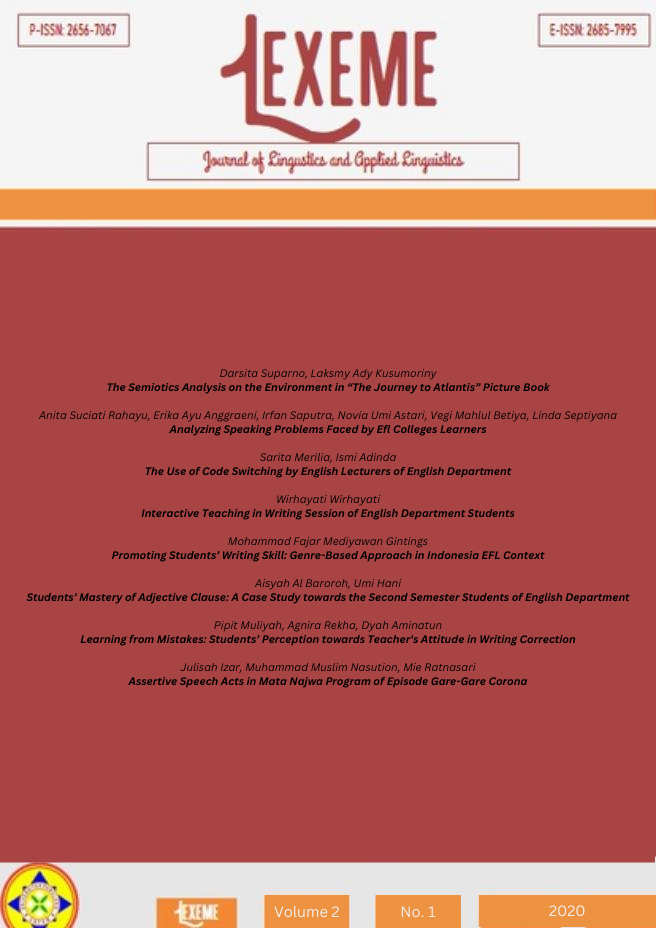The Semiotics Analysis on the Environment in “The Journey to Atlantis†Picture Book
DOI:
https://doi.org/10.32493/ljlal.v2i1.6986Keywords:
Semiotics, verbal and nonverbal symbols, Elisabetta Dami’s The Journey to Atlantis Picture Book, Peirce’s theoryAbstract
This study aimed (1) to describe the semiotic process of environment symbols in The Journey to Atlantis, (2)to generate the meaning of identified symbols which are shown through verbal and non-verbal contained in The Journey to Atlantis. This is a descriptive qualitative study trying to identify and analyze semiosis process of environment symbols, and describe the found verbal and nonverbal symbols in Elisabetta Dami’s The Journey to Atlantis Picture Book using semiotic theory by Charles Sanders Peirce (1991). The data for the finding and analysis were taken from Elisabetta Dami’sThe Journey to Atlantis (2012) Picture Book. The study shows that there are 40 icons in form of words and 36 onomatopoeia as verbal symbols, and 40 picture decribe Atlantis environment and 18 color as nonverbal symbols which are related to the environment.References
Ajayi, V.O. (2017). Primary Sources of Data and Secondary Sources of Data. 1–6. Bianquin, N. & Sacchi, F. (2017). More than Just Pictures: Using Picture Books to Broaden Young Learners’ Disability Understanding.†Proceedings 1(9):890. Buchler, J. (2006). The philosophy of Peirce: Selected writings. The New England Quarterly 14(3):601-612. Calero, H. H. (2005). The Power of Nonverbal Communication How You Act Is More Important Than What You Say. Los Angles: Silver Lake Publishing. Callow, J. (2018). Classroom assessment and picture books – Strategies for assessing how students interpret multimodal texts.†Australian Journal of Language and Literacy 41(1):5– 20. Chandler, D. (2006). Semiotics the Basics, Second Edition. Second. New York: Routledge. Damy, E. (2012). The Journey to Atlantis. New York: Scholastic. Hidayat, R. S. 1988. Pengantar Linguistik Umum. edited by H. Kridalkasana. Yogyakarta. Karina, M. D. (2017). English onomatopoeia in children books.†Sanata Dharma.van Kraayenoord, Kraayenoord, and S. Paris. 1996. “Story Construction from a Picturebook: An Assesment Activity for Young Learners.†Early Childhood Research Quarterly. 11(2). 41– 61. Liszka, J. J. (2012). A General Introduction to the Semeiotic of Charles Sanders Peirce. Bloomington: Indiana University Press. Mantei, J, & Kervin, L. (2014). Interpreting the images in a picture book: Students make connections to themselves, their lives and experiences English Teaching Practice and Critique 13(2).76–92. Mushodiq, M. A. (2018). Tanda peircian dan maknanya dalam unsur intrinsik cerpen "IndamaYa'ti Al-Masa Karya Naguib Mahfouzâ€. Jurnal Lingua. 13(1). Nöth, W. (2011). The criterion of habit in Peirce’s definitions of the symbol. Transactions of the Charles S. Peirce Society. 46(1). 82-90. Ozsezer, M. Bulut, S., & Canbazoglu. (2018). Picture in children’s story books: Children’s perspective. International Journal of Educational Methodology. 4(4).103–115. Pearson, D. (1993). Teaching and learning reading: Reasearch perspective. Language Art. 70(2). 02–11. Peirce, C. (1991). Logic as Semiotic. The Theory of Sign. London: Cambridge University Press. Pettersson, S. (2000). Graphic Symbols Design and Meaning. in Griffin, W. J. Gibbs, & V.S. Williams (Eds. Pruitt, Sarah. (2018). “The Top Thoeries of Atlantis.†Civilization. Yu, Hailing, and Song, Z.. (2017). Picture–text congruence in translation: Images of the zen master on book covers and in verbal texts. Routledge Taylor and Francis Group. 27(5). 604-623,.







